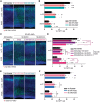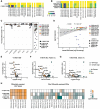ADAT3 variants disrupt the activity of the ADAT tRNA deaminase complex and impair neuronal migration
- PMID: 40120092
- PMCID: PMC12404733
- DOI: 10.1093/brain/awaf109
ADAT3 variants disrupt the activity of the ADAT tRNA deaminase complex and impair neuronal migration
Abstract
The ADAT2/ADAT3 (ADAT) complex catalyses the adenosine to inosine modification at the wobble position of eukaryotic tRNAs. Mutations in ADAT3, the catalytically inactive subunit of the ADAT2/ADAT3 complex, have been identified in patients presenting with severe neurodevelopmental disorders. Yet, the physiological function of the ADAT2/ADAT3 complex during brain development remains totally unknown. Here, we investigated the role of the ADAT2/ADAT3 complex in cortical development. First, we report 21 neurodevelopmental disorders patients carrying biallelic variants in ADAT3. Second, we used structural, biochemical and enzymatic assays to deeply characterize the impact of those variants on the ADAT2/ADAT3 structure, biochemical properties, enzymatic activity, and tRNAs editing and abundance. Finally, in vivo complementation assays were performed to correlate functional deficits with neuronal migration defects in the developing mouse cortex. Our results showed that maintaining a proper level of ADAT2/ADAT3 catalytic activity is essential for radial migration of projection neurons in the developing mouse cortex. We demonstrated that the identified ADAT3 variants significantly impaired the abundance and, for some, the activity of the complex, leading to a substantial decrease in inosine 34 levels with direct consequence on tRNAs steady state. We correlated the severity of the migration phenotype with the degree of loss of function caused by the variants. Altogether, our results highlight the critical role of ADAT2/ADAT3 during cortical development and provide cellular and molecular insights into the pathogenic mechanisms underlying ADAT3-related neurodevelopmental disorders.
Keywords: ADAT3; deamination; neurodevelopmental disorders; neuronal migration; tRNA.
© The Author(s) 2025. Published by Oxford University Press on behalf of the Guarantors of Brain.
Conflict of interest statement
A.R. and G.O. are employed by the Company Arcensus GmbH. D.D.N. is listed as an inventor on a patent application filed by the Max Planck Society pertaining to the mim-tRNAseq technology.
Figures






Update of
-
Neurodevelopmental disorders associated variants in ADAT3 disrupt the activity of the ADAT2/ADAT3 tRNA deaminase complex and impair neuronal migration.medRxiv [Preprint]. 2024 Nov 18:2024.03.01.24303485. doi: 10.1101/2024.03.01.24303485. medRxiv. 2024. Update in: Brain. 2025 Sep 3;148(9):3407-3421. doi: 10.1093/brain/awaf109. PMID: 38496416 Free PMC article. Updated. Preprint.
References
-
- Agris PF, Vendeix FA, Graham WD. tRNA’s wobble decoding of the genome: 40 years of modification. J Mol Biol. 2007;366:1–13. - PubMed
MeSH terms
Substances
Grants and funding
- Broad Institute of MIT and Harvard
- UM1 HG008900/HG/NHGRI NIH HHS/United States
- R01HG009141/National Heart, Lung and Blood Institute
- Fondation pour la recherche médicale
- ANR-10-LABX-0030-INRT/INSERM
- HHMI/Howard Hughes Medical Institute/United States
- Ministère de l'Enseignement Supérieur de la Recherche et de l'Innovation
- R01 NS035129/NS/NINDS NIH HHS/United States
- U01 HG011755/HG/NHGRI NIH HHS/United States
- ANR-DFG ANR-19-CE16-0023/INSERM
- UM1HG008900/National Heart, Lung and Blood Institute
- ANR-21-CE12-0026/INSERM
- 803825/Max Planck Society
- R01 HG009141/HG/NHGRI NIH HHS/United States
- ANR-10-IDEX-0002-02/INSERM
- U01HG011755/National Heart, Lung and Blood Institute
- NE2315/2-1/INSERM
- YIP 4833/Max Planck Society
- ANR 20-SFRI-0012/INSERM
- ANR-17-EURE-0023/INSERM
- ANR-10-INBS-0005-01/INSERM
LinkOut - more resources
Full Text Sources
Molecular Biology Databases

